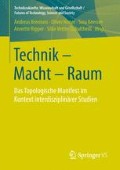Zusammenfassung
Dem relationalen Raumbegriff, den das Topologische Manifest favorisiert, steht traditionell ein als „absolut“ bezeichneter Raumbegriff gegenüber, aus dessen Sicht „Raum“ nicht das Produkt von räumlichen Relationen ist, sondern eine (im Grenzfall) inerte „Bühne“ für die räumlichen Gegenstände bildet. Bekannt geworden ist beispielsweise die Debatte zwischen Leibniz und dem Newton-Schüler Samuel Clarke. Bevor der relationale Raumbegriff mit dem topological turn in den Geistes- und Kulturwissenschaften Karriere machte, geriet er aus Sicht von Physik und Metaphysik immer weiter unter Druck. Der Artikel zeichnet diese Diskussionslinie nach, indem er die gegen den relationalen Raumbegriff vorgebrachten Argumente sowie die Bemühung, ihn gegen diese abzusichern, rekonstruiert und sie in kritischer Absicht gegen das Topologische Manifest in Stellung bringt. Dazu diskutiere ich zunächst die Bedeutung physikalisch orientierter Raumzugriffe für den Raumbegriff des Manifests, bevor ich die wesentlichen Veränderungen, die der relationale Raumbegriff durchgemacht hat, für das Manifest anschlussfähig mache. Dies erlaubt schließlich eine kritische Bewertung des Manifests, um dessen Leistungen, aber auch Begrenzungen herauszustellen.
Abstract
The relational concept of space, which is favored by the Topological Manifesto, is traditionally contrasted with an “absolute” concept of space that considers “space” to be not the product of spatial relations but an (in the limiting case) inert “stage” for spatial objects. For instance, we are aware of the debate between Leibniz and Newton’s student, Samuel Clarke. Prior to becoming popular, due to the topological turn in the humanities and cultural sciences, the relational concept of space was subjected to increasing pressure from the perspective of physics and metaphysics. This contributions traces this line of discussion by reconstructing both the arguments that were brought up against the concept and the effort to protect it against them, as well as positioning it critically with respect to the Topological Manifesto. Hereby, I first discuss the significance of physically oriented access to space for the space concept of the manifesto and then describe the main changes that the relational concept of space underwent before I make them compatible with the manifesto. Thus, the manifesto can be evaluated critically, in order to emphasize both its achievements and limitations.
Der vorliegende Artikel ist eine überarbeitete Version meines gleichnamigen Vortrags von der Konferenz Technospaces, 18. – 20. März 2015 in Darmstadt.
Access this chapter
Tax calculation will be finalised at checkout
Purchases are for personal use only
Preview
Unable to display preview. Download preview PDF.
Literatur
Bartels, A. (2012). Der ontologische Status der Raumzeit in der allgemeinen Relativitätstheorie. In M. Esfeld (Hrsg.), Philosophie der Physik (S. 32 – 49). Frankfurt am Main: Suhrkamp.
Carrier, M. (2012). Die Struktur der Raumzeit in der klassischen Physik und der allgemeinen Relativitätstheorie. In M. Esfeld (Hrsg.), Philosophie der Physik (S. 13 – 31). Frankfurt am Main: Suhrkamp.
Denker, K. (2011). Das Konzept der Topologie. In S. Alpsancar, P. Gehring, & M. Rölli (Hrsg.), Raumprobleme. Philosophische Perspektiven (S. 219 – 234). München: Fink.
Kanitschneider, B. (1971). Geometrie und Wirklichkeit. Berlin: Dunker & Humblot.
Kant, I. (1974). Kritik der reinen Vernunft. Frankfurt am Main: Suhrkamp.
Lehmkuhl, D. (2012). Super-Substanzialismus in der Philosophie der Raumzeit. In M. Esfeld (Hrsg.), Philosophie der Physik (S. 50 – 69). Frankfurt am Main: Suhrkamp.
Leibniz, G. W. (1996). Hauptschriften zur Grundlegung der Philosophie. Teil I. Hamburg: Meiner.
Maudlin, T. (1993). Buckets of Water and Waves of Space. Why Spacetime Is Probably a Substance. Philosophy of Science, 60 (2), 183 – 203.
Author information
Authors and Affiliations
Corresponding author
Editor information
Editors and Affiliations
Rights and permissions
Copyright information
© 2018 Springer Fachmedien Wiesbaden GmbH, ein Teil von Springer Nature
About this chapter
Cite this chapter
Denker, K. (2018). Newtons Eimer. In: Brenneis, A., Honer, O., Keesser, S., Ripper, A., Vetter-Schultheiß, S. (eds) Technik – Macht – Raum. Technikzukünfte, Wissenschaft und Gesellschaft / Futures of Technology, Science and Society. Springer VS, Wiesbaden. https://doi.org/10.1007/978-3-658-15154-6_18
Download citation
DOI: https://doi.org/10.1007/978-3-658-15154-6_18
Publisher Name: Springer VS, Wiesbaden
Print ISBN: 978-3-658-15153-9
Online ISBN: 978-3-658-15154-6
eBook Packages: Social Science and Law (German Language)

